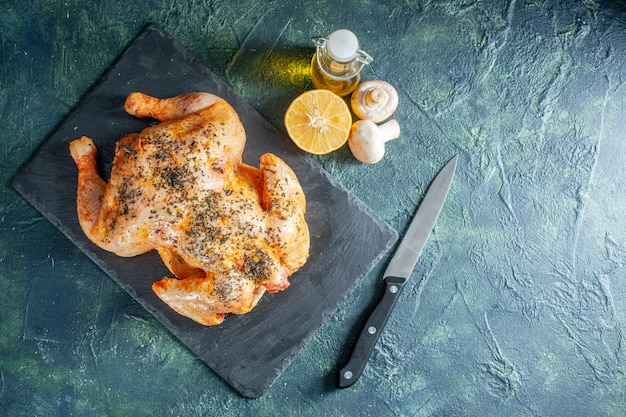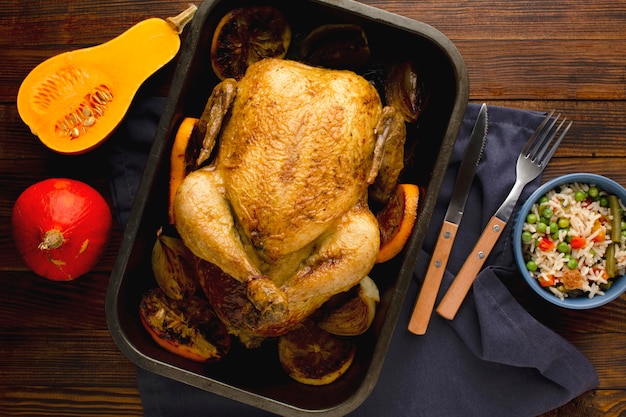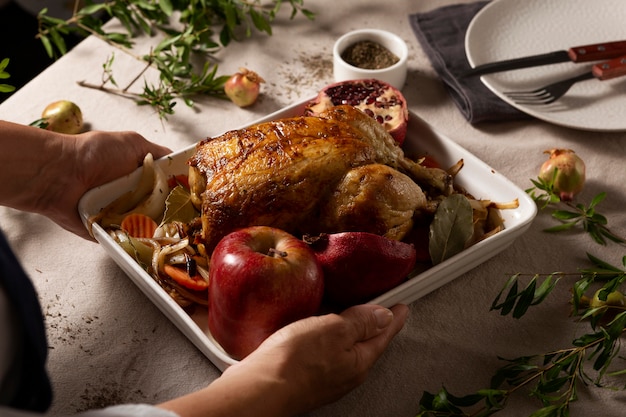Chicken! It's a kitchen staple, right? Easy to find, pretty affordable, and incredibly versatile. But let's be honest, cooking chicken perfectly can be a bit of a challenge. You need that perfect balance: juicy, tender, and with a beautiful golden-brown crust. It's like a little balancing act, and I'm here to help you become a chicken-cooking champion!
I've been cooking chicken for ages, and I've made my fair share of mistakes along the way. Remember that time I overcooked a whole roast chicken? It was drier than the Sahara Desert! But I've also had my moments of triumph, like the time I nailed the perfect crispy skin on a pan-fried chicken breast - pure culinary magic!
This guide is all about sharing what I've learned – the good, the bad, and the downright delicious. So, grab your apron, your trusty spatula, and let's dive into the world of perfect chicken!
(Part 1) Picking the Perfect Chicken

Understanding Chicken Cuts
First things first: you need to choose the right cut of chicken for what you're making. It might seem obvious, but trust me, it's crucial!
whole chickens: These are amazing for roasting. They're the best value for your money and ideal for family dinners or feeding a crowd. Think Sunday roast, folks!
chicken breasts: Perfect for grilling, pan-frying, or baking. They're lean and versatile, great for salads, sandwiches, or even a quick weeknight meal.
chicken thighs: These are juicier and more flavorful than breasts, and they're more forgiving when cooked, meaning less chance of drying out. Perfect for roasts, stews, or grilling.
chicken wings: Let's be real, who doesn't love a good chicken wing? They're great for grilling, baking, or frying. They're a party must-have, no doubt!
chicken drumsticks: Another delicious option, these are great for grilling, roasting, or frying. They're a classic BBQ staple!
Buying the Best Chicken
Once you've chosen your cut, it's time to pick the chicken itself. Here's what to look for:
Freshness: The chicken should have a fresh, slightly sweet smell, not a sour or ammonia-like odour.
Colour: The chicken skin should be a pale, creamy colour, not grey or greenish.
Texture: The chicken should be firm and springy to the touch, not mushy or slimy.
Packaging: Make sure the packaging is intact and that the chicken hasn't been punctured.
Important Chicken Storage Tips
Storage: Store your chicken in the refrigerator at a temperature below 4°C (40°F). Always keep it separate from other foods to prevent cross-contamination.
Freezing: You can freeze chicken for up to 4 months. Make sure to wrap it tightly to prevent freezer burn.
Thawing: Thaw chicken in the refrigerator for a few days or in a cold water bath. Never thaw at room temperature, as this can encourage bacteria growth.
(Part 2) Preparing Your Chicken for Cooking

Washing Chicken: The Great Debate
You've heard the debate, haven't you? To wash or not to wash? Personally, I'm in the "don't wash" camp. Here's why:
Spreading Bacteria: Washing chicken can actually spread bacteria around your kitchen, contaminating other surfaces and utensils. It's like a tiny bacteria party you don't want to host!
Water Sprays: When you wash chicken, water droplets can carry bacteria and spray onto nearby surfaces. It's a bit like a bacterial sprinkler system!
No Need for Washing: Cooking chicken thoroughly to an internal temperature of 165°F (74°C) will kill any harmful bacteria. Just make sure you cook it properly!
Patting Dry is Key
Instead of washing, pat your chicken dry with paper towels. This helps to remove any excess moisture, which can steam instead of crisp up the skin during cooking. You want a crispy skin, not a soggy mess!
Seasoning is Everything
Before you cook your chicken, give it a good seasoning. This will add flavour and make the chicken more delicious.
Salt: Always season your chicken with salt. It helps enhance the flavour and draws out moisture. Salt is the secret weapon!
Pepper: Black pepper is a classic choice, but feel free to experiment with different spices like paprika, cayenne pepper, or smoked paprika. Spices are like the personality of your dish!
Herbs: Fresh or dried herbs can add a wonderful depth of flavour to your chicken. Some popular choices include thyme, rosemary, oregano, and parsley. Herbs add a touch of freshness!
Garlic: Garlic is a great way to add flavour and aroma to your chicken. You can use whole cloves, minced garlic, or garlic powder. Garlic is always a good idea!
Marinating for Added Flavor
If you're looking for extra flavour, try marinating your chicken. A marinade can help tenderize the chicken and add a beautiful depth of flavour.
Acidic Ingredients: Marinades often include acidic ingredients like vinegar, lemon juice, or yogurt. These help to tenderize the chicken.
Oil: Oil helps to create a barrier between the chicken and the marinade, preventing the chicken from becoming too dry.
Seasonings: Be creative with your seasonings! Use herbs, spices, garlic, or even soy sauce to add flavour to your marinade. Let your creativity run wild!
(Part 3) The Art of roasting chicken

The Golden Rules of Roasting
Roasting is a fantastic way to cook a whole chicken, resulting in a succulent and flavorful dish. Here's how to get it right:
Preheat Your Oven: Always preheat your oven to the correct temperature before you put the chicken in. This ensures even cooking and a beautiful golden-brown crust.
Seasoning is Essential: Generously season the chicken with salt, pepper, and any other herbs or spices you like. Don't be shy with the seasoning!
Stuffing It or Not? Stuffing your chicken can add moisture and flavour, but be sure to cook the stuffing separately to ensure it reaches a safe internal temperature. Safety first!
Temperature Control: Roast the chicken at a moderate temperature (around 350°F or 175°C) for a good amount of time. Find that sweet spot for even cooking!
Resting Time: Let the chicken rest for at least 10 minutes after cooking. This allows the juices to redistribute throughout the meat, resulting in a more tender and juicy chicken. Patience is key!
roasting time and Temperature
The roasting time will vary depending on the size of the chicken, but here's a general guideline:
| Chicken Size | Roasting Time | Temperature |
|---|---|---|
| 2-3 pounds | 1 hour 15 minutes - 1 hour 45 minutes | 350°F (175°C) |
| 4-5 pounds | 1 hour 45 minutes - 2 hours | 350°F (175°C) |
| 6-7 pounds | 2 hours - 2 hours 30 minutes | 350°F (175°C) |
Checking for Doneness
The best way to know if your chicken is cooked through is to use a meat thermometer. Insert the thermometer into the thickest part of the thigh, making sure it doesn't touch any bone. The chicken is cooked through when the internal temperature reaches 165°F (74°C). Don't guess, use a thermometer!
(Part 4) pan-frying chicken Perfection
The Skill of Pan-Frying
Pan-frying is a quick and easy way to cook chicken breasts or thighs, resulting in a crispy skin and juicy meat. It's a classic cooking method for a reason!
Get a Good Pan: Choose a heavy-bottomed pan that can distribute heat evenly. Cast iron or stainless steel are good choices.
The Right Oil: Use a high-heat oil that won't smoke easily, such as vegetable oil, canola oil, or peanut oil.
Heat It Up: Heat the oil over medium-high heat before adding the chicken. This helps to ensure a crispy crust.
Don't Overcrowd: Make sure you have enough space in the pan for the chicken to cook evenly. If you overcrowd the pan, the chicken will steam instead of crisp up.
No Touching! Resist the urge to move the chicken around in the pan too much. Let it cook undisturbed for a few minutes on each side to develop a nice crust.
Check for Doneness: Use a meat thermometer to check the internal temperature of the chicken. It should reach 165°F (74°C) for breasts and 175°F (80°C) for thighs.
Tips for Perfect Pan-Frying
Skin Side Down First: Start by cooking the chicken with the skin side down. This helps to crisp up the skin and create a delicious barrier.
Lower the Heat: Once the chicken is browned on one side, lower the heat to medium and flip it over. This helps to prevent the chicken from burning on the outside while it cooks through on the inside.
Add Some Butter: Towards the end of cooking, add a knob of butter to the pan. This will baste the chicken and add extra flavour. Butter makes everything better!
(Part 5) grilling chicken Like a Pro
Setting the Stage for Grilling
Grilling chicken is a fantastic way to enjoy the smoky flavour of the grill and create a delicious meal. It's the perfect summer meal!
Clean Your Grill: Start by cleaning your grill grates to prevent sticking. A wire brush is a good tool for this. A clean grill is a happy grill!
Preheating is Crucial: Preheat your grill to medium-high heat. This will ensure that the chicken cooks evenly and develops a nice char. Get those grill grates hot!
Keep It Even: Use a meat thermometer to check the temperature of the grill grates to ensure an even cooking temperature. No hot spots!
Tips for Grilling Chicken
Don't Forget the Salt: Season your chicken generously with salt, pepper, and any other herbs or spices you like. Seasoning is key to a flavourful grill!
Grilling Time: Grilling times will vary depending on the thickness of the chicken and the heat of your grill. Pay attention to those grill marks!
Flip Once: Flip the chicken once during cooking, making sure it has a nice char on each side. A good char is a sign of a well-grilled chicken!
Resting is Key: Let the chicken rest for a few minutes after grilling. This allows the juices to redistribute throughout the meat, resulting in a more tender and juicy chicken. Be patient, let those juices settle!
(Part 6) baking chicken for Simplicity
The Easiest Way to Cook Chicken
Baking chicken is a simple and straightforward way to cook chicken breasts, thighs, or even whole chickens. It's a great option for a fuss-free meal!
Preheat Your Oven: Set your oven to 375°F (190°C). Get that oven nice and toasty!
Prepare Your Baking Dish: Line a baking dish with parchment paper or foil to make cleanup easier. Less mess, more time for eating!
Get Seasoning: Season the chicken generously with salt, pepper, and any other herbs or spices you like. Don't be shy with those flavours!
Time for the Oven: Place the chicken in the baking dish and bake until cooked through. The time will vary depending on the size and thickness of the chicken.
Temperature Check: Use a meat thermometer to check the internal temperature of the chicken. It should reach 165°F (74°C) for breasts and 175°F (80°C) for thighs. Don't forget to check for doneness!
Tips for Baking Chicken
Moisture is Key: To prevent the chicken from drying out, you can add some moisture to the baking dish. You can use a small amount of broth, water, or even wine. Keep it moist!
Basting for Flavor: During baking, you can baste the chicken with pan juices or a mixture of butter, herbs, and spices. This will add flavour and keep the chicken moist. Basting adds a touch of magic!
Finishing Touches: Towards the end of baking, you can add a few slices of lemon or orange to the dish. This will add a citrusy flavour and aroma. A citrusy burst of flavour is always welcome!
(Part 7) Mastering the Art of Chicken Breasts
The Chicken Breast Challenge
Chicken breasts can be notoriously tricky to cook perfectly. They're lean and can dry out easily, but with a few tricks, you can achieve juicy and tender chicken breasts every time. Don't be afraid of the chicken breast challenge!
Butterfly for Even Cooking: Cut the breast lengthwise, almost all the way through, and open it up like a butterfly. This helps to ensure even cooking and prevents the chicken from drying out. Like a culinary origami!
Pound it Out: Pound the breast to an even thickness. This will ensure that it cooks evenly and prevent it from becoming tough. A good pounding makes for a tender breast!
Lower the Heat: Cook chicken breasts over medium heat to prevent them from drying out. You can also use a meat thermometer to check for doneness. Slow and steady wins the race!
Rest is Vital: Let the chicken breasts rest for a few minutes after cooking. This allows the juices to redistribute throughout the meat, resulting in a more tender and juicy chicken. Give those juices time to settle!
(Part 8) Understanding Chicken Thighs
The Juicy Alternative
Chicken thighs are the dark meat heroes of the chicken world. They're juicier and more flavorful than breasts, and they tend to be more forgiving when cooked. Embrace the dark meat!
Bone-In or Boneless? You can find chicken thighs with the bone in or boneless and skin-on or skinless. Choose your preference based on your recipe and cooking method. It's all about personal preference!
Skin for Flavor: If your thighs have skin, leave it on! It adds flavour and helps to keep the meat moist. Skin is in!
Slower Cooking: Chicken thighs can handle longer cooking times without drying out. This makes them perfect for roasting, grilling, or pan-frying. They're the ultimate slow cooking heroes!
(Part 9) Cooking Chicken Safely
food safety is Paramount
Food safety is crucial when cooking chicken. Here are some important tips to follow:
Thorough Cooking: Cook chicken to an internal temperature of 165°F (74°C) for breasts and 175°F (80°C) for thighs. Don't underestimate the power of a meat thermometer!
Use a Meat Thermometer: A meat thermometer is the best way to ensure your chicken is cooked through. It's your best friend in the kitchen!
Separate Surfaces: Use separate cutting boards and utensils for raw chicken and other foods. Keep those bacteria separate!
Wash Your Hands: Wash your hands thoroughly with soap and water after handling raw chicken. Washing hands is crucial!
Clean Your Kitchen: Clean all surfaces that came into contact with raw chicken with hot soapy water. A clean kitchen is a happy kitchen!
(Part 10) The Art of Serving Chicken
Making Your Chicken Shine
Once you've cooked your chicken perfectly, it's time to serve it up in style.
Slicing Techniques: Slice chicken breasts lengthwise to create thin, even pieces. Slice chicken thighs across the grain for a tender bite. Slicing technique makes all the difference!
Sides That Complement: Choose sides that complement the flavour of your chicken. Some classic choices include roasted vegetables, mashed potatoes, rice, or salads. Let the flavours mingle!
Sauces for Extra Flavor: Add a sauce to your chicken for an extra layer of flavour. Some popular options include gravy, pan sauce, or a creamy herb sauce. Sauces are like a finishing touch!
FAQs
1. How long does chicken take to cook?
The cooking time for chicken will vary depending on the cut, size, and cooking method. Here's a general guideline:
Chicken Breasts: 5-7 minutes per side for pan-frying, 20-30 minutes for baking.
Chicken Thighs: 10-15 minutes per side for pan-frying, 30-40 minutes for baking.
Whole Chicken: 1 hour 15 minutes - 2 hours 30 minutes for roasting.
2. How do I know if chicken is cooked through?
The best way to know if chicken is cooked through is to use a meat thermometer. The internal temperature should reach 165°F (74°C) for breasts and 175°F (80°C) for thighs. You can also check for doneness by cutting into the thickest part of the chicken. The juices should run clear and the meat should be firm to the touch.
3. What happens if I overcook chicken?
If you overcook chicken, it will become dry and tough. This is why it's important to cook chicken at the correct temperature and for the right amount of time. Use that thermometer and don't rush the process!
4. Can I reuse marinade on chicken?
It's not recommended to reuse marinade that has been in contact with raw chicken. This is because the marinade may contain bacteria that can cause illness. Safety first!
5. Can I freeze cooked chicken?
Yes, you can freeze cooked chicken for up to 3 months. Make sure to store it in an airtight container or freezer bag to prevent freezer burn. Freezing is a great way to save leftovers!
I hope this guide has helped you unlock the secrets to cooking chicken perfectly. Remember, it's all about understanding the fundamentals and experimenting with different cooking techniques. So, get in the kitchen, try out some new recipes, and have fun! And if you ever have any questions, just ask!
Everyone is watching

How to Cook Frozen Lobster Tails Perfectly: A Step-by-Step Guide
RecipesLobster. Just the word conjures up images of lavish meals, special occasions, and a taste of luxury. But let's...

Pigs in a Blanket Cooking Time: How Long to Bake for Perfect Results
RecipesAh, pigs in a blanket. Just the name conjures up images of those delightful little parcels of crispy pastry en...

Pork Fillet Cooking Time: How Long to Cook It Perfectly
RecipesPork fillet, or tenderloin as it's sometimes called, is a real favourite in our house. It's so versatile, and...

The Ultimate Guide to Cooking Delicious Frankfurters
RecipesLet's face it, we all love a good frankfurter. It's a classic, simple, and always satisfying. But let's be rea...

The Ultimate Guide to Tender, Juicy Pulled Pork
RecipesRight, let's talk pulled pork. It's one of those dishes that just screams "comfort food," doesn't it? I mean...
